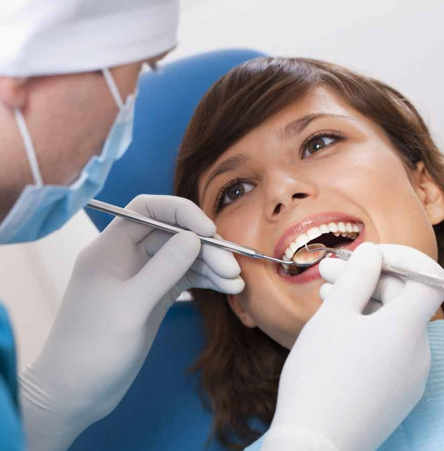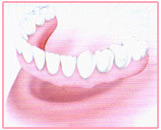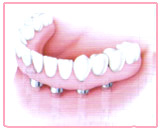


Removable full denture

Implant Supported Overdenture
Dental implants in the back of your mouth we refer to the replacement of premolars and molars in the upper and lower jaw in the back of the mouth.
Missing back teeth greatly impairs your chewing efficiency. Using your front teeth to chew food eventually causes arthritic changes in TM Joint which leads to facial pain and head aches. People who are very thin will also have sunken cheeks giving them an old age look. Most often patients neglect this area as this is not cosmetically visible in your smile. Many years of toothless condition leads to severe shrinking of jaw bones in that region. This makes the placement of implants very demanding and additional surgical procedures may be needed to augment the shrunken bone.
Posterior teeth replaced will be limited till the second molars. Third molars or wisdom tooth is not replaced by dental implants. It is generally considered the first molars give 90% biting efficiency. Second molars give 7% biting efficiency. Third molars have less than 3% biting efficiency.
Placing dental implants in the back of the mouth is technically more demanding as the vital structures like nerves and sinuses are present in this region.A detailed x-ray examination will give an indication about the available bone in the jaw for placement of implants. On examination if the bone volume is less then bone augmentation procedures are needed to place the implants. This can be done safely by trained maxillofacial surgeons. So if you have been told that there is insufficient bone by any implant dentist, your next step will be to meet a maxillofacial surgeon trained in implant dentistry.
It is also noticed that some implant dentists who are not trained in placing implants in compromised jaw bone in the back of the mouth removes good front teeth to place implants so that the back teeth can be cantilevered from the front implants which is not a good practice.
Some of the surgical procedures to augment jaw bone that can be mentioned are as below.
Long periods of tooth less condition will lead to shrinking of jaw bone both in vertical and horizontal dimension. At scientific dental clinic Dr Thomas routinely does ridge split technique using piezo electric bone surgery unit. This specialized machine work with piezoelectric mechanics. The knife edged thin bone is split and widened to accommodate the correct size of implants and interposition bone graft is used at the time of placing implants to fill the dead spaces. . This is a highly successful surgical treatment.Dr kuldeep singh usually does this under local anesthesia .Careful handling of the bone is very important to maintain the blood supply of the bone and in turn the integration of implant.
This also is done as two stage procedure where the ridge split is done with bone grafting as the first procedure. Once the bone is augmented to the desired width after a healing period of six months implants are placed. But in 99% of the cases Dr Thomas places implants at the time of ridge split and a second surgery is avoided. Those who are not trained to do this procedure usually discourage patients advising them that they have no bone and hence they are denied the opportunity of replacing lost back teeth with dental implant treatment thus compromising the quality of life.
Long periods of tooth less condition will lead to shrinking of jaw bone both in vertical and horizontal dimension. To increase the width and height of the jaw bone to accommodate a good sized implant a piece of bone (block of bone) is harvested from a site near to the implant placement site. The usual site for harvesting the block graft is from the chin, ramus of the mandible, ankle of the mandible etc. Dr Thomas does this procedure also under local anesthesia. The graft harvested is fixed on to the thin jaw bone where an implant cannot be placed otherwise. Fixation of the block graft is done by titanium osteosynthesis. Interposition graft is also used along with this. Since the donor and recipient sites are in same region patient discomfort is minimal.
In severely shrunken lower jaw the inferior dental nerve will traverse through the center of the bone. Any surgical intervention will violate the neuro – vascular bundle leading to neurological deficit. Using specialized equipments and instruments this nerve can be tunneled out from the bone and implants can be placed safely in the bone.
In severely shrunken lower jaw the inferior dental nerve will traverse through the center of the bone. Any surgical intervention will violate the neuro – vascular bundle leading to neurological deficit. Using specialized equipments and instruments this nerve can be tunneled out from the bone and implants can be placed safely in the bone.
The maxillary sinus if they are very big then the available bone under the sinus for the placement of implants will be minimal. A trained surgeon can safely access the sinus directly from the front wall of the sinus. A window is made in the front wall of the sinus without damaging the sinus membrane lining the sinus. Maintaining the integrity of this sinus membrane is the key to the success of the integration of the graft. This sinus membrane is lifted and bone graft is placed inside the sinus under the membrane which consolidates to form thick bone for the implants to be placed. This is also routinely done by Dr Thomas under local anesthesia.
If the implant can be secured achieving a primary stability then sinus grafting and placement of implants can be done at the same time. But if the residual bone under the sinus is too thin then sinus grafting alone is done as a first stage. After a healing period of six months implants are placed in the grafted bone as second procedure.
Usually a drill is used to make site for placement of implants. Under the sinus if the bone is very thin then using a drill most certainly damages the sinus membrane. Instead an instrument called osteotome is used safely to push the membrane up at the same time an implant site is created. Then bone grafting materials are placed under the sinus membrane thru the access made. Most often the implants are also placed simultaneously.
Using specialized surgical instruments the implant site is expanded or widened to accommodate implants. This also can be safely done under local anesthesia.
If you are missing a tooth and if you are advised to grind the adjacent good teeth to place a dental bridge consider implant. Ask your dentist why implants are not recommended instead of grinding down good teeth. Remember the life of an average tooth supported bridge is anywhere from 10 to 11 years. You will loose more teeth and ultimately more implants are needed. Then why not consider implants in the first instance.Each tooth is an organ of your body and don’t allow anybody to damage it and remember you have the right to choose what is best for your health.
Implant treatment is 98% successful. An integrated implant is 8 times stronger than natural tooth and can last a life time.